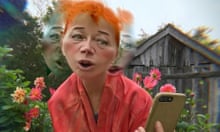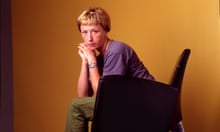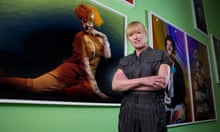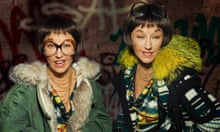“Cindy prefers not to comment on her Instagram posts.”
This was the reply from Cindy Sherman’s New York gallery, Metro Pictures, when I asked for a statement. A private Instagram account run by Sherman featuring a new series of selfies was recently made public, creating an art world sensation overnight. Sherman has a long history of dramatically staged self-portraiture, and in a sense pioneered the idea of the “selfie” decades before social media began.
Art world luminaries are fawning over the images, sharing their thoughts in the comments underneath each post. But a mystery still lingers. Part of the confusion is that the work seems to be made specifically for Instagram, and not as a physical work for a future show in a gallery. With no clarification from Sherman herself, it makes for a fascinating quandary.
Sherman’s Instagram posts are a series of wildly distorted selfies, flower arrangements and disturbing hospital self-portraits, with oxygen tubes up her nostrils. There is a video shot from the perspective of someone lying in a hospital bed. The viewer is made to wonder how much of this is real, whether Sherman was actually hospitalized, or if it’s mere fabrication. The images are also affected by an array of decorative filters available on Instagram that animate or change the facial features of users. The line between real life and posed events that Instagram affords heightens the confusion as to what is actually happening.
That area between real life and the theatre of the selfie is what Sherman is already so adept at presenting, but in the context of an era where Donald Trump has repeatedly criticized women for their physical appearance, her images of distorted female faces take on a much more defiant tone.
Sherman’s Instagram posts accomplish something not seen in recent years – they hold up a dark mirror to our era of self-obsession. Artist Richard Prince accomplished this with his recent Instagram-themed work, but in a different way. Prince also printed the images for physical exhibitions at Gagosian Gallery – something Sherman may or may not end up doing. The subsequent legalities associated with Prince’s series took his social media interaction in a much different and more controversial direction than Sherman’s.
This article includes content provided by Instagram. We ask for your permission before anything is loaded, as they may be using cookies and other technologies. To view this content, click 'Allow and continue'.
What does our digital landscape mean for the changing nature of exhibiting one’s work? Is it better or worse than showing in a real gallery space? “The difference between exhibiting online over exhibiting in a real space is ‘depth’ in every possible sense,” said New York writer and curator Jeffrey Grunthaner. “You can’t really take a point of view on an image; there’s no genuine scale to it. It’s simply there, floating in digitality. There’s a certain potential for dictating exactly how viewers look at an artwork that is quite appealing. As I see it, the difficulty in accepting the ascendancy of exhibiting online relates to the proscribed corporate identity most online venues have.”
New York gallerist Avi Gitler is similarly unsure. “They accomplish different goals,” he says. “I’m old fashioned, so while I appreciate the power of engaging people on digital platforms in 2017, it just doesn’t compare for me to the experience of seeing art in person. The majority of my gallery sales are made through digital imagery sent to clients, but I feel that we should continue to mount shows – while so many other brick and mortar galleries close. There is no question in my mind that a local gallery engages people more substantively than connecting on Instagram.”
In many cases, Instagram is not art but a digital dumping ground – a playground for society’s worst narcissists. For an artist like Sherman to be using it as an exhibition space raises the bar for users seeking attention or claiming to be artists.
The rise of smartphones has also led to a rise in those who consider themselves professional photographers. Density of pixels in a digital image is how photography is now widely judged, an arbitrary measurement. As a result, digital processing has almost completely replaced traditional wet photography. The line between an amateur and professional photographer is gone, forcing digital image making as the collective photographic medium.
“The problem for human artists is that the next evolutionary intelligence (AI/singularity), is now the target audience,” digital artist Josh Harris, from documentary We Live in Public, told me.
Programs like Google Deep Dream create and reprocess imagery using artificial intelligence and arbitrary image manipulation. But in the end, it’s a question of art and who is making great art. Cindy Sherman has demonstrated a level of art that few can claim online or offline, without the aid of technological innovation.











Comments (…)
Sign in or create your Guardian account to join the discussion